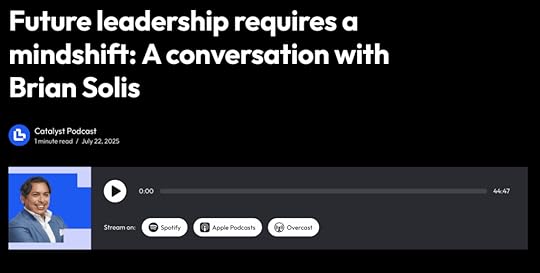Brian Solis's Blog, page 4
September 6, 2025
Brian Solis on Mindshift: Reimagining Customer Experience in the Age of AI
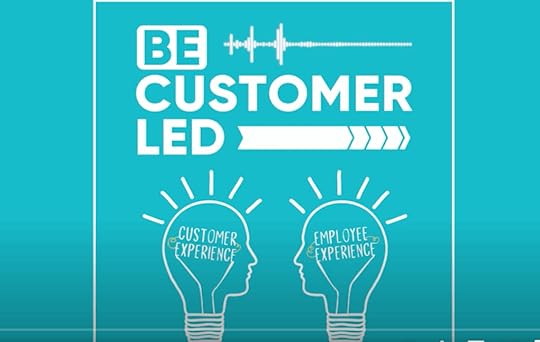
In this episode, we welcome Brian Solis, Head of Global Innovation at ServiceNow, a nine-time best-selling author, keynote speaker, and digital futurist. Starting the conversation, Brian shares the inspiration behind his latest book, “Mindshift“, and emphasizes the importance of empathy and a truly customer-centric mindset. Through examples from Amazon, Disney, and IKEA, Brian illustrates how organizations can create meaningful and memorable experiences that drive both loyalty and growth.
The conversation also explores the evolving role of AI, shifting from automation and cost savings to augmenting human interactions and delivering personalization. Finally, Brian calls on leaders to embrace innovation, cultivate empathy, and invest in customer experience as a catalyst for transformation and long-term success!
[00:31] Guest Introduction
[02:00] The Concept behind “Mindshift”
[04:07] Empathy and Customer-Centric Approach
[13:30] The Role of AI in Customer Experience
[26:34] Developing Leadership Skills for Customer Experience
[31:25] The Future of AI in Customer and Employee Experience
Transcript0:00[Music] Welcome to be customer-led, where we’ll explore how leading experts in customer0:08and employee experience are navigating organizations through their own journey
0:14to be customer-led and the actions and behaviors employees and businesses
0:20exhibit to get there. And now, your host, Maru Brown.
0:29[Music] Hi everyone and thanks for tuning in to another episode of Be Customerled.0:37Boy, do we have a treat for you. Today we have Brian Solless, one of the
0:43leading authorities on how to navigate technologydriven disruptive change so that it doesn’t overwhelm you or derail
0:50you, but instead it delivers exceptional value for your business. Now, Brian has
0:55so many accolades, I could take up half the program just listing them, but we won’t do that. So, I’ll just give you a
1:01few. He’s a nine times best-selling author, including his latest book, Mind Shift: Transform Leadership, Drive
1:09Innovation, and Reshape the Future. We’re going to talk about that some today. He’s also an international
1:15keynote speaker and he’s a renowned expert on the future of technology and business trends with more than 60
1:22research papers published in leading publications like Forbes and CIO magazine and Fast Company. Welcome to
1:30the program, Brian. Oh, it’s my pleasure. Thank you for that uh generous introduction.
1:36Well, we’re really glad to have you and excited about uh what we’re going to
1:41talk about. And you know, to write a book, I mean, I’ve written a couple myself, so I know you got to have fire
1:47in your belly to write a book, especially when you you’re holding down a full-time job, you know, at the same
1:54time. And you’ve done it nine times, right? So, tell me, what was the fire in your belly that got you to write Mind
2:00Shift? That’s going to be a whole program right there, but I’ll do my best to keep it uh to keep it short. Yeah. I
2:06love the way you described it, fire in your belly, because that one was
2:12certainly hot. Uh and it was burning for a long time. I just had watched massive
2:19disruptive waves crash over and over and over again. Uh and there are specific
2:25events that that really drove this, but let’s just say more recently with the
2:30pandemic, uh the climate change, uh artificial intelligence, just the incredible
2:38disconnect that’s happening between people and technology and disinformation. I
2:45mean, we’ve got no shortage of disruptions, right? Yeah. Just all of these things. And and I think the one pattern that they all
2:50have is that we generally whether as a business or as a society or as
2:57governments, we don’t see them as disruptions. We see them as let’s try to understand them and let’s put them into
3:04the box of business as usual. Uh and I think artificial intelligence of all of
3:09them is the one where we could start by putting it in the box of of uh business as usual like i.e. automation, chat
3:16bots, etc. But it is going to require absolute transformation because it
3:22allows us to do something that other disruptions haven’t given us. And that is the ability to do what we didn’t do
3:30yesterday. Whereas we tend to look at every disruptive wave as how can we use
3:35this to do what we did or navigate what we did yesterday better tomorrow. I I guess the the the uh the pandemic was
3:43one of those disruptions that made us realize that we had to fundamentally shift how we think about some things
3:49because you couldn’t just do things uh the the same way that that you have done before, right? But hey, listen. Uh what
3:57are some of the give me one or two of the key takeaways you want for people to to to take from mind shift? We’ll jump
4:04in right there and then we’ll start, you know, digging deeper into some of these things. Yeah, absolutely. Well, let’s put it
4:09into the context of your audience. To be customerled, a mind shift is to see something, to
4:17recognize something that you couldn’t see before that you give yourself the
4:22space to explore what you didn’t see before to then inspire new ideas, new
4:29opportunities, and new ways forward. I think that’s the mind shift in its most simplistic sense. But what it’s really
4:36calling for is a new generation of leaders. I think we’re often waiting for someone to tell us what to do. We’re
4:41often waiting for that leader to guide us, kind of give us the insights around like for example, what do we need to know about AI so we know we can move
4:47forward together. But I actually believe that this is a moment that we are that leader. We need to become that leader.
4:54We need to convince ourselves that if we’re waiting for someone to tell us what to do, we might be on the wrong side of innovation. Uh and so one of the
5:01biggest takeaways for the book or is to recognize that as you’re reading it, you
5:06are that leader even if it’s not a role or a title or a hierarchy that you have
5:12a voice in how to shape the future. So for example, if you think about the
5:18pandemic, we saw overnight transformations uh for customer centric
5:23technologies like e-commerce or curbside pickup for example. uh suddenly
5:29everything needed to be digital and mobile so that the customer could get in contact with your business. Uh the same
5:36thing happened for employees. They had to be able to work from home. And so that sudden shift shouldn’t have taken a
5:43pandemic to accelerate that digital accessibility and that digital engagement because it had been happening
5:48for a long time. Same is true for artificial intelligence. The only wave
5:54of AI that’s new to us is generative AI. uh and because it was consumerfacing
6:00technology this time it blew up in terms of adoption and disruption. So when when
6:07I think about being customer-led the mind shift for me is that customer should always be front and center. How
6:13is that customer different than me? How is their day-to-day life or their
6:20day-to-day work different in the day in the life of to the my day in the life
6:25of? So, for example, as someone who’s worked in CX, uh someone who’s worked in marketing, someone who’s worked in
6:31business transformation, it’s always an inside out job, meaning
6:37I’ve got my processes, I’ve got my systems, I’ve got my budgets and resources and all of the constraints that come with it. We have a way of
6:43working and when something new comes along, we try to bring it into this system and bolt it on, plug it in, uh
6:50and create new touch points, for example. But it’s not it’s not anything that it’s truly customer-led or
6:56customer- centered. So if I step back and I look at my mind shift and I think
7:03all right well what am I not seeing? Well for example we know the customer 70% to 80% of all decisions start right
7:10here and they don’t always end there because something’s broken in the
7:16process. Uh and that is an opportunity for us to say well how do they want to make a decision? How do they how are
7:21they influenced? What’s intuitive to them? Uh how does their brain work? For example, if you if you look at a Tik Tok
7:27user and you put them on a regular website with with forms and chat bots, that’s that’s just a different brain. So
7:34I think about it I think about I know it’s a long answer, but I’ll I’ll come to the end here. I think about it this
7:40way. To be customer led is to be empathetic. And to be empathetic is to see the world as your customer sees it
7:47and let it inspire you. And then go back to your journey. go back to your your processes, your systems to see what’s
7:54not in alignment with them. Well, you know, it it it’s kind of interesting because I wrote a book of my
7:59own called uh a blueprint for customer obsession where I laid out these principles of customer obsession. And
8:05one of them is to give customers what they want before they know they need it,
8:10right? You think about some things that that you know have done that. I mean, like, uh, who ever thought that you’d be
8:17using your watch a as part of your your navigation in your car, right? Because
8:22it’s it’s kind of pinging you when it’s time for you to make a turn or or maybe your watch using, you know, helping you
8:29with uh health things like, you know, your heart rate and all of those kinds of things. That was giving customers
8:35something that that they wanted before they knew they even needed. And I and and I’m thinking like the principles
8:41that you have in mind shift, how can that help companies like deliver on that
8:47that you know tenant of of customer obsession? How how can it help people unlock the ability to give customers
8:54what they want before they know they need it? It’s a philosophy that is is both
9:00wonderful but also difficult. And what makes it difficult is is the
9:06lack of empathy. And it’s not that people don’t care. It’s just that we’re we’re human beings and
9:12we have biases. And those biases are really how we see the world versus how someone else sees the world. Uh as an
9:20executive, I have I have my my constraints. I have my politics. I have things I have to try to navigate. And I
9:26try to do my best within that paradigm to deliver for the customer. But if I’m
9:32not taking the time to understand life from the customer’s perspective,
9:39then I’m never I’m never going to be able to see the challenges they have, the struggles that they have, and to
9:46introduce new opportunities for them to better experience something or to better
9:51do something in a way that becomes refreshing.
9:56That’s something that they they can’t live without. So if you think about how Steve Jobs approached it, we could go
10:02back to the Xerox days where he discovered the mouse or he discovered
10:07graphical user interface. He didn’t invent them. He just saw that it could make the lives
10:13easier for someone who was using a computer for the first time. Those were not intuitive. They were DOSsbased, very
10:21difficult. and he recognized that if I could if I could unlock the power of
10:26these machines so that the everyday person could embrace them, then that would be magical. Uh, and that same way
10:33with Disney with his cartoons and the and Snow White, the first uh animated motion picture. Nobody was waiting
10:40around for an hour and a half cartoon until he gave it to them. But he studied he studied how people can be engaged uh
10:47and and and how and and and what they might be lacking in their day-to-day life. So he stepped out of his world and
10:54into theirs. That’s the mind shift. The first few chapters are really about how do you get out of your own mind so that
10:59you can embrace a beginner’s mind so that you can see things as if it was a new because when you can see things like
11:05with childlike wonder, everything becomes possible. Maybe even too much. Uh so but that that’s the opportunity
11:14and one of the analogies I love to use uh it’s an old show. I don’t know if you ever used to watch it, Undercover Boss.
11:19Yeah. Yeah. That is that is for me the manifestation of empathy because what ends up
11:26happening this the stories are always the same. somebody at the top
11:31goes into disguise, whether it’s working uh in the back of the store room or it’s
11:37working on the front line with other with other employees or it’s actually being the customer. Then they actually
11:43see and feel what it’s like to be someone else. And then they can’t unsee
11:49it. They can’t unfeill it. And everything changes by the end of the episode. There’s crying, there’s
11:56laughter, there’s applause because now suddenly we were one. We were together. And that that’s the
12:03power of that mind shift. Well, you know, it’s interesting because I I’ll give you one that doesn’t even require
12:09you to to be undercover, right? So, uh Jeff Bezos was uh taking calls in in a
12:15contact center. a call came in and you know the the customer’s information
12:20popped up on the screen and and the the rep sitting next to him says, “Well, they’re going to want to return that.”
12:27And sure enough, that’s what the customer wanted. And he he was like, “Well, you know, how’d you know that?”
12:33And she says, “Well, you know, I see that all the time. They they always want to return that, right?” And uh it was
12:40like okay something’s wrong with that picture because you should have a way to communicate that so we can stop that
12:45from happening right and that gave rise to you know uh something called the
12:50andon cord at Amazon you know something that I had I got the privilege of
12:56running for a while but that that was an innovation that made it possible for us to take down things that were were
13:01causing issues uh for for customers so that we could fix them systemically right and and I think that kind of lines
13:08up with with with what you’re describing. But so what do you think of this notion then that if people work
13:16backwards from the customer or they work backwards from the employee, they would
13:21identify some of the most innovative and some of the most disruptive disruptive opportunities to utilize AI in their
13:29environments. Oh, absolutely. Absolutely. So if you think about the box of business as usual
13:35uh with AI, what we’re seeing right now out of uh out of the box is automation. Let’s take out costs. Let’s increase
13:42efficiencies and scale. There’s nothing wrong with that. It’s sound business thinking. So I don’t want to I don’t
13:47want to tell anyone that they’re not doing the right thing. You have to do that. But now
13:52that becomes the new AI powered status quo, right? Everybody’s doing that. So what are you going to do differently?
14:00And if we take that customer centric approach, how does the customer experience this? Well, let’s let’s go
14:08back to the good old days of contact centers, decision trees, and automated
14:13systems and IVRs. No customer to this day wakes up and says, “Boy, I cannot wait to call a contact center and talk
14:20to a machine where I have to scream representative 30,000 times until I can talk to a human being.” No customer ever
14:27says that. It sucks. It’s a horrible experience. But businesses do it because it saves costs. It’s efficient. It still
14:33gets them hopefully to the outcome that they need. But all of these things, including AI powered automation, comes
14:39at the cost of the customer’s experience. And I always I always put
14:44that apostrophe s. It’s the customer’s experience, not customer experience, it’s theirs.
14:50And so that’s a that’s a mind shift for me to constantly remind myself that I am not the customer. So if you take Tik Tok
14:59for example, say we have someone who is actively looking using Tik Tok,
15:04constantly scrolling. One of the things that happens to their brain is that it moves so much faster than the normal
15:12brain uh for better or worse. So they listen to podcasts, they watch videos at 1.2
15:181.5x speed because that’s just the way that their brain’s working. They’re consuming much more information. And now
15:25you put that brain into your customer journey and you are going to find parts
15:31where they are just going to break down or get frustrated or feel horrible. Um,
15:36and so I say that because what you’re looking to do is to deliver a better
15:41experience. That word itself is something I think we take for granted in in the world of customer service,
15:47customer experience, customer marketing. Experience is actually an emotion. It’s
15:52not a series of transactions. It’s not technology. It’s just an emotional reaction to at any given moment. And
15:59there are only two experiences that people will remember. Experiences that are amazing and experiences that suck.
16:07And and you got to ask yourself, what are you designing for? Uh because most of the time we’re just we’re designing
16:13for the forgettable or worse, the ones that are awful. And that for me is that
16:21mind shift. How can I use AI? How can I use technology to deliver a more
16:27meaningful, relevant experience that people will remember in
16:33some way, shape or form. And that I learned all of that uh by studying
16:38Disney Imagineers. Yeah. Yeah. that that that actually is one of the things that uh I spent some
16:45time on uh in blueprint for customer obsession. I delved into how Walt Disney
16:51pioneered the Disney method with if it can be dreamt, it can be built and how
16:56he allowed himself to pursue ideas that others would have found to be fantastical or even preposterous. And he
17:03kicked the tires on those things and it led to some amazing stuff. So tell me
17:09about what you’ve learned from the Disney Imagineers and how folks can can use that to to have a mind shift about
17:16how they tackle some of these things like AI. Oh wow. Well, first of all, I love that
17:22message. To this day, I still have two mentors as part of my AI. Uh, one is
17:29Steve Jobs and the other one is Walt Disney. I use them as personas for inspiration as I think about um getting
17:36that type of push that type of inspiration and motivations because it’s it’s very easy to fall into complacency.
17:45It’s very easy to fall into the trap of well we can’t do that. Uh we’ll never make that happen. There’s no resources.
17:52How are we going to get budget? This is the way it’s always been done. But what I learned from Imagineers is just that
17:58one is that fantastical is the aspiration,
18:03but more so uh one of the things that I learned Joe Roie was a was a big inspiration of mine as well. He’s a
18:10former Imagineer was to remember the person on the other
18:16side of the experience. Coming from Silicon Valley, it’s very easy to get caught up in the tech and and and and
18:23the amazing capabilities that you couldn’t do before. And but it’s it’s also important to remember that someone
18:29on the other side is going to use it, experience it, to feel it, to to
18:34remember it. And those those lessons that I that I that I got from the Imagineering the Imagineers reminded me
18:42that you have to design for those emotions. In fact, Joe Roie u he famously said that if you design an
18:51experience it has to be extraordinary because if it’s not extraordinary it’s
18:56forgettable and that was that was powerful uh to me and so what I
19:02translated that into is in the study of psychology and the study of experience
19:08itself which is the word means how you feel in a particular moment how I’m
19:14experiencing this right now is is how I’m feeling about it. And how I’m feeling about it is how I’m going to
19:21remember it or how I’m not going to remember it. And there the there are two experiences that people remember,
19:28experiences that are wonderful and experiences that suck. And so being here in Southern California, I have a Disney
19:35pass and I go to Disney of one because my my my daughters love it, but two
19:40because I I want to I want to touch that magic. I want to remind myself of what that experience is like. And so I know this is a long answer to your question,
19:47but the Imagineers who designed the Disney experiences at the park go
19:52through painstaking detail around the the the trees, the paint to hide things
19:58to make you feel like you’re immersed in a completely different world where outside of that park is Anaheim, for
20:04example. You don’t see it, you don’t hear it, you don’t feel it. But even the concrete and the things that they put in
20:10the concrete, the trash cans, everything goes to this this incredible amount of detail. So that the experience you feel
20:17and the experience you remember is by design. And so when we talk about
20:22customer experience or CX, we forget that that X, that word experience is
20:28about how people feel on the other side of a touch point. How people feel along the way of a journey, how people feel
20:35after they become a customer. So, for example, we take experience out of the equation. We automate, we put chat bots
20:43in place. We we put automation systems in place so that you’re never talking to
20:49a human being or at least getting a human-like experience. Why? Because it’s
20:54expensive to serve a customer. So, therefore, uh we have to look for ways to take costs out at the expense of your
21:01experience, which is ironic. So I think about Peter Ducker who who famously said
21:07that the purpose of a business is to create and keep a customer. It is more expensive to lose a customer and have to
21:14get another customer than it is to keep that customer and to keep that customer happy. And I’d love to see CX
21:19professionals earn a seat at the seauite table to remind leaders that when you
21:25invest in experience, you get it back in ways that go beyond NPS, in ways that go
21:32beyond advocacy. You get growth. And if you can cultivate that relationship, you
21:39have a you don’t just have a customer for life. you have a customer who is
21:44spending more time and more of their resources with you. And that is another
21:49thing that I’ve learned from Disney, especially going to the parks cuz it’s getting more and more expensive. But but
21:55I I I love it and they love it and the memories we have together are appreciative of those experiences that
22:02are designed and the memories that they create. You know, the interesting thing is that they call it the most magical place on
22:08earth. You know, some people would say you can’t sustain that level of
22:15excitement over and over and over and over and somehow they seem to do it,
22:22right? And other businesses seem to do it. I mean, like, you know, Chick-fil-A has this notion of what they call the
22:27second mile, right? and and so their folks are basically
22:33um you know trained that you don’t just deliver what the customer asks for, you
22:39give something over and above. What is that thing that you give as your second
22:44mile thing and obviously Chick-fil-A has a religious bent and and they take that
22:50right out of a place where Jesus said, “Hey, if somebody tells you to go with you one mile, go with them too.” and and
22:56and so they actually are basing it on that and telling their folks, hey, listen, don’t just do what the person asked you
23:03to do. Do something extra. And that of course creates that specialness in the
23:09experience for you, right? I open the door for you and I put an umbrella over your head to take you out to the car so
23:15you don’t have to walk in the rain, you know? I come over and fill your cup or something like that. So, and it’s in the
23:21same spirit of what the Imagineers do and what you just described, right?
23:27Can I just build on that real quick cuz you reminded me of something. Um, it’s also it’s not just the Imagineers, it’s
23:33the cast members at the park who find special ways to make you feel like you
23:38that you matter. Uh, I used to actually do work with Chick-fil-A and the experience team and I remember I had an
23:46observation role just kind of sitting in the restaurant and watching watching a manager and the manager’s team do
23:54exactly what you what you just described, the second mile. It was magical to watch it. There’s the the
23:59food is one one thing, but people come back for that experience.
24:04They want to feel like they felt that day again. Uh and that’s and that’s what you want. Uh and
24:11the thing about that is as a leader you have to do two things. One, I get that you have a P&L, but if you can drive
24:19growth by delivering better experiences, Allah Disney or Chick-fil-A, we know
24:26from a business standpoint, it works. You just have to want to do that. And
24:31then also, you have to hire the people who want to do that. And you have you have to measure them for doing that and
24:39you have to reward them for doing that because if if you do not it is very easy
24:45to get caught up in the transaction of the business and that’s where most
24:50businesses fall down. Most customer journeys are incredibly transactional. They’re connected. Well, they’re not a
24:56connected, but they are a string of touch points all with different
25:01measures, all run from different groups. And therefore, that that second mile can
25:07never be integrated across the whole experience unless you want it to. And
25:12that that is where I think the controldelete moment needs to happen. What kind of experience do you want to
25:18deliver? Do you value your customer? And do you believe that if you invest in your customers experience and that
25:24relationship that you will make that back multiffold versus it being a cost
25:30setter? How do you help leaders hone or or develop their skills around um you
25:38know this this ability to to kind of go after go after these things. But I think
25:44in some businesses the whole notion of of bringing forward even some of these
25:49types of ideas gets shut down very fast. I mean I imagine you know like in
25:54another business when somebody came up with the whole idea of cashierless checkout which you know Amazon kind of
26:01like brought to the four somebody might have been shut down right out of the gate and like what are you talking about
26:07cashierless checkout? But in a company like Amazon and me having been on the inside, I understand exactly how that
26:14does not get shut down and how it rises to the top. How can you help leaders to develop this and you know do you do you
26:22deal with that a bit in mind shift? Well, thank you for asking and uh the
26:27mind shift is really about the journey of opening your mind,
26:33changing your mind. Mhm. but more importantly to allow
26:38yourself to receive the types of signals you were not able to receive before. So, for example, if I
26:46was sitting in a Chick-fil-A and I was watching the manager and the manager’s team walk around the restaurant and do
26:52something very nice for someone who’s sitting there, like offer to refill their cup or to put a little special
26:59thing down on the table as a as a reward of a reward of recognition, for example.
27:04Those are things that I might not have seen if I weren’t ready to see them. I might have just seen a busy restaurant.
27:10I might have just seen people happily enjoying their lunch or their dinner. Um, but when when you have a a more open
27:16mind and you’re ready to receive like the gifts that you see all around you, those are the things that inspire you to
27:22want to do things differently, to want to to add your touch, your flavor to
27:28that opportunity that you didn’t see before. And then you start seeing trends differently and how you might react to
27:34those trends. And so that’s the whole idea of of what it means to to to go
27:39through that mind shift journey. Now the way that I have to help executives sort
27:45of have their own mind shift is we have to start from a place of of awareness.
27:53And not to get too philosophical here but most of us are not self-aware. There’s a saying uh Anniian I believe is
28:01who said this uh we don’t see the world as it is. We see the world as we are. And so when we see the world as we are,
28:07we tend to miss all of those special things because we’re busy achieving the goals and the pressures and running from
28:14meeting to meeting and all of the things that that we do that comprise our day in order for us to deliver the type of
28:21success that we’re we’re being measured for. So, I got to take that I got to
28:26take that person out of that mix and I have to inspire them in a way that they didn’t know they could be inspired. So,
28:34let’s talk about that that that cashierless checkout experience. So, for
28:39example, with one with one of the retailers that pioneered that, not Amazon, I worked with executives
28:47uh to shop in their own stores. They hadn’t done that actually in a long
28:54time. And I gave them homework. Different types of personas would need
28:59different types of things. And they all took on that type of persona to shop for
29:05those things, to ask for help, to or try to ask for help uh and then to check out
29:11and then to come back and talk about what that experience was like. And the first thing that was really interesting
29:18to me was that they just didn’t want to do it and hadn’t done it in a long time.
29:25And then afterwards, it’s like any team building exercise, I suppose. It’s like, ah, maybe you were you were trepidacious
29:31of actually doing it. And then afterwards, it’s like, oh my gosh, that was amazing. It brought us closer together. Uh, and so once they feel what
29:38that experience is like, you can’t unfeill it. You can’t unsee it. And so that led to innovations in in selfch
29:44checkout. That led to innovations in experience. That led to innovations in in having someone there to help you when
29:50you need it and how they approach you. Like maybe a cast member might approach you at Disney or how someone might
29:56approach you in Chick-fil-A. So these are things that they almost have to experience for themselves. And then
30:02that’s that’s one part of it. The other part is you still have to speak the language of the business. So it’s one thing to be an advocate for the customer
30:09or the voice of the customer. The other thing is to tie everything that you’re saying into the language of the business
30:14so that not only are you helping the customer get a better experience, but you’re demonstrating how doing so
30:20impacts the business positively. So that there I I I hate to say this, but that so that there is actual ROI that all of
30:29all of the leaders can then understand that we’re making this investment for something beyond just goosebumps.
30:36Cool. One of the things we got to do be before we we finish this off, we got to
30:41talk about the AI aspects of this and and you you you’ve hit on that a little bit, but I I’m wondering what do you see
30:48as you know some of the best opportunities for AI to to really help disrupt the
30:56status quo in the customer and the employee experience. And you know, like we’re we’re we’re thinking about mind
31:02shifts and I just feel like we can plant the seed for people so that they can have some ideas about how to do that.
31:08We’re obviously not going to exhaust that, but any thoughts on that subject? Oh, you boy, where do I start? I mean,
31:16we’re we’re using AI in the way that we’ve used every technology revolution.
31:22It’s in particular CX. Think about the IVR. um when you used to call a human
31:28being then that got outsourced then the IVR came in and I there’s a joke like
31:34the test of anyone’s true character is how you how you react as you’re trying to get a human being when you call
31:40customer service uh operator representative a uh and if you if you if
31:48you Google something like uh like an image search uh for customer service a lot of the images are someone screaming
31:54into the phone But it is sort of the the use of technology, not sort of, it is
31:59the use of technology to get further away from people. And I and I want people to hear that. Like that’s exactly
32:05what you’re doing. You’re getting further away from people. And if you do it without trying to put some Disney
32:11magic in the moment, in that touch point, even with technology, then you’re also doing it at the cost of how they
32:17feel and what they remember. Okay. Yeah, you know, let me let me just throw in something here because I I I
32:24think of Intel inside. You know, you remember Intel inside the Pentium chip.
32:30Yeah. And I I I I always think that, you know, with AI, there’s got to be almost
32:36like a sticker that says human inside because you got to bring that working backwards, you know, from the customer
32:43and the human element into how AI is deployed so that people can feel like,
32:48oh, somebody thought through this for me before they deployed this, right? Yeah. Yeah. Exactly. Cuz nobody wakes up
32:56and says, “Boy, I can’t wait to call customer service today or I can’t wait to talk to a chatbot today.” You even if
33:03you talk to a chatbot and you and you train it to be more personal or you train it to ask questions to make
33:10someone feel a little bit more at ease or that you you’re you you remind them of how important they are. there are
33:17nuances that you can design into the script or into the or into the model that are not only human but make someone
33:25feel special. So that’s that’s really all we have to do with AI. I mean it’s it’s inevitable we’re here we’re going
33:31to use it to automate but we could also use it to augment. And so I’ll give you an example the IKEA story. I don’t know
33:37if we talked about this behind the scenes, but the IKEA story, they in they
33:42implemented a chatbot for customer service uh with the intention of like many contact centers to deflect. What
33:50they did was the deflection was so effective. I think that they actually deflected 47% of inbounds, which was wow
33:58pretty pretty big number. So they could have said, “Wow, that’s fantastic. We automated customer service. People seem
34:05to like it.” And so maybe we don’t need these agents anymore and let’s take out costs, you know, because that’s what
34:11customer service is. It’s a cost center. But instead, they looked at the other 53%. What are those what are those
34:18customers not getting? What can’t we deliver? And they realized that actually
34:23there’s a lot of opportunity for interior design. People had questions about the furniture or the design for
34:29their office or for their home. And so what they did was they reskilled those agents to become interior designers and
34:37they delivered a new type of service to the customer that actually generated revenue. So you save while still giving
34:44a good experience and you deliver a new experience that that I think generated a billion euro in the in its first year.
34:51That’s that’s an incredible story with the customer experience elevating as a
34:56result too. Yep. That that is cool. And I’ve I’ve seen some things out there that that are
35:03are pretty incredible that are um you know in the augmentation space like
35:08where uh people are actually um where where where they’re they’re using
35:14simulations to to train agents that that get agents,
35:20you know, to the customers faster, more experienced, more ready. you know, I’ve
35:25seen a number of different things that have been in the augmentation space that have uh that that have been uh super
35:32helpful. Um and uh I know that there will be more disruptions. One that I
35:37don’t think anybody ever thought about was uh you know using AI to actually um
35:43score uh phones that were being uh traded in and so they could give more
35:49accurate scoring on how to value those and and everything like that.
35:54Well, look, uh, Brian, it’s been a pleasure talking to you about the mind shift and and all the different ways
36:01that comes to life. You know, for for people who want to get in touch with you, maybe they want to continue this
36:07conversation. What’s the best way for them to do that? Well, I’m pretty much at Brian Soloulless on all your favorite
36:13platforms and then also Brians.com is is a good is a good hub or LinkedIn, I
36:20suppose, is also is also good. I would love I’d love for you to read mind shift. Uh it is a book that basically
36:27says we need a new type of leader especially in an era of AI so that we don’t just do we don’t just use
36:33technology and every wave of of technology that’s to come that we that
36:38we react to it in the ways that we’ve always reacted to it. instead that we start to get a little bit of foresight
36:45and we start to put experience into the mix for employees and for customers and we start to be the type of leader that’s
36:51looking forward and looking for ways to unlock new value and unlock new
36:57experiences. So, I I just wanted to say Marmu, thank you for the opportunity to be part of this conversation and uh I
37:04now have a another uh another Disney friend uh in the mix uh and to bring
37:10that magic uh everywhere. Well, thank you. I certainly appreciate you uh making the time to join us on the
37:16program. I’m sure that folks who have listened in have uh gotten some things
37:22that they can take away, that they can go and that they can use right away. And thank you to all of you folks who have
37:28have tuned in to to listen to this. Unfortunately, we’re going to have to wrap it up here for today. But please
37:34come back again because we’re going to have another exciting program for you next time. But for now, that’s all and
37:42uh look forward to you joining us again. Thank you, Brian. Thank you.
37:48Thanks for listening to Be Customer with Maru Brown. We are grateful to our
37:54audience for the gift of their time. Be sure to visit us at becussled.com
38:00for more episodes. Leave us feedback on how we’re doing or tell us what you want to hear more about. Until next time,
38:08we’re out.
The post Brian Solis on Mindshift: Reimagining Customer Experience in the Age of AI appeared first on Brian Solis.
September 1, 2025
Brian Solis to Speak at The Next Revolution of AI on Both Days
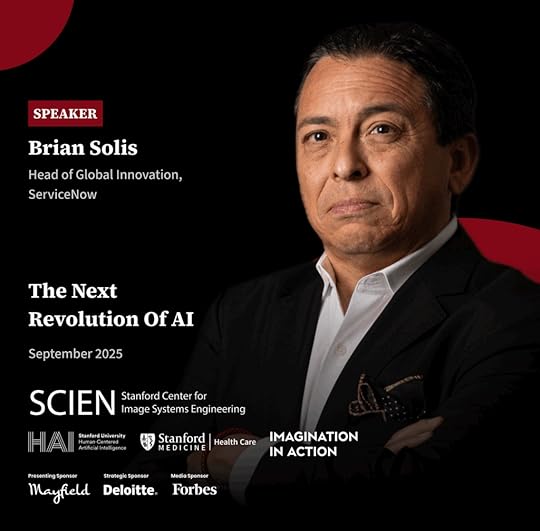
Excited to announce that I’m joining an amazing array of thinkers, researchers, founders, investors, and leaders at “The Next Revolution of AI: Impact.” The event is hosted at Google on Monday and at Stanford on Tuesday.
On Monday, I’ll be at Google in the Lightning Talk session outdoors in the afternoon sharing “A Dynamic Vision for AI.”
On Tuesday, I’ll be at Stanford University in the Frontier Salon, exploring, “Enterprise AI: Accelerating Productivity and Innovation.”
Proud to represent ServiceNow and the futures research we’re doing in the Innovation Office.
Hope to see you there. Please reach out if so!
Google Day 1 Program
Stanford Day 2 Program
A very special thank you to John Werner and Imagination in Action! 
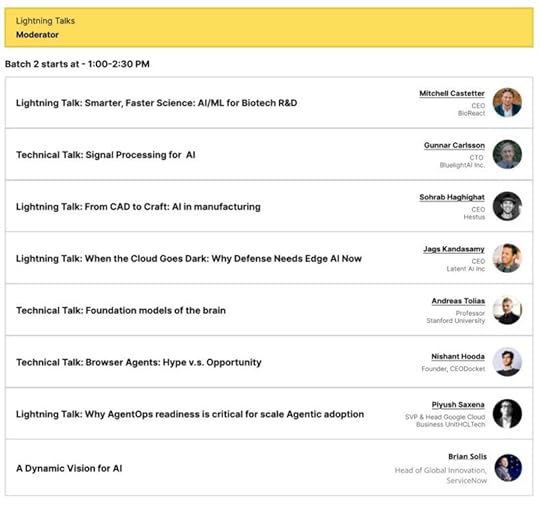
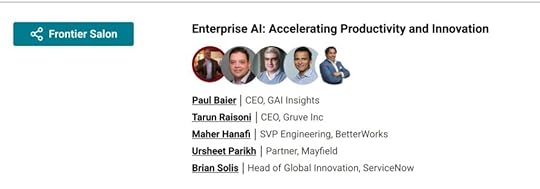
The post Brian Solis to Speak at The Next Revolution of AI on Both Days appeared first on Brian Solis.
August 20, 2025
Cybernews: Does AI Affect Job Satisfaction?

by Adi Gaskell, Cybernews
Employee engagement has sunk to a 10-year low, as only around a third of American employees are engaged, with this figure barely budging over the past decade, according to data from Gallup.
I’ve written in the past about the relative optimism (or pessimism) with which workers and leaders are viewing the impact AI is likely to have on the workplace, and there is a clear distinction between those who think AI will make working life better and those who believe it will strip work of meaning (if it doesn’t strip us of work entirely).
Reshaping the workplaceResearch from the University of Pittsburgh explores the topic in more depth. As before, the study strikes a generally positive tone, suggesting that exposure to AI hasn’t had a negligible impact on either our job satisfaction or our mental health.
Indeed, the researchers go as far as to suggest that using AI may actually be making us happier, albeit only by a small amount. It’s a finding shared by recent research from Denmark’s Happiness Research Institute, with this boost generally caused by the parallel between the adoption of AI and optimism about the future.
The Pittsburgh researchers looked at two decades’ worth of data from the German Socio-Economic Panel, which allowed them to examine how people feel in professions that are heavily exposed to AIcompared to those with less exposure.
“Public anxiety about AI is real, but the worst-case scenarios are not inevitable,” the researchers say.
“So far, we find little evidence that AI adoption has undermined workers’ well-being on average. If anything, physical health seems to have slightly improved, likely due to declining job physical intensity and overall job risk in some of the AI-exposed occupations.”
A nuanced pictureThe researchers urge a note of caution, as their analysis looked primarily at AI exposure on a task level. They acknowledge that when workers self-report their level of AI exposure, this corresponds with a slight dip in job satisfaction.
What’s more, they also acknowledge that many of the respondents were older workers, so not those perhaps most vulnerable to automation, and the study also only covered the initial phases of the technology’s rollout in Germany.
Moreover, the study found that while there were no significant average effects on job satisfaction, life satisfaction, or mental health, there were small improvements in self-rated physical health and satisfaction with health, particularly among lower-educated workers. This likely stems from a reduction in the physical demands of certain jobs, as AI systems increasingly take on repetitive or strenuous tasks.
There was also a modest reduction in the number of hours people worked each week, though without corresponding decreases in income or employment rates.
Yet, despite these generally reassuring signals, the researchers caution that their findings reflect the early stages of AI adoption in Germany—a country with strong labor protections and a relatively measured pace of technological change. It remains to be seen how outcomes might differ in more fluid labor markets or among younger cohorts entering workplaces already saturated with AI.
“We may simply be too early in the AI adoption curve to observe its full effects,” they say. “AI’s impact could evolve dramatically as technologies advance, penetrate more sectors, and alter work at a deeper level.”
Looking forwardThe importance of optimism was underlined by the futurist Brian Solis. He suggested that we reimagine our roles for a world dominated by AI, and recommended being proactive rather than reactive. This process should also involve looking at our role systemically, reviewing both our own role and the wider industry.
He also reminds us to keep searching for purpose. Even in a world of mass unemployment, assuming there is some form of universal basic income to prevent widespread destitution, people will still need meaning to be happy. Work has traditionally played a big role in providing us with that meaning, and Solis argues that the happiest people will be those who can define their role in terms of its impact.
Read the full article here.
The post Cybernews: Does AI Affect Job Satisfaction? appeared first on Brian Solis.
August 19, 2025
An Interview with Il Sole 24 Ore: Leadership and AI – rethinking business models and strategies
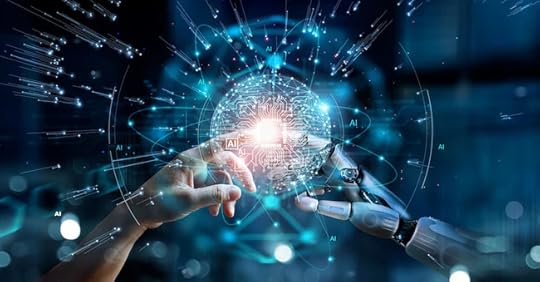
AI is not just automation, but potential to expand human capabilities and redefine leadership models; an interview with Brian Solis
Is artificial intelligence synonymous with automation? Absolutely yes, but not only. This is because the transformative powers of algorithms and generative technologies are indeed changing our lives (private and work) and the way we make decisions, but too often the business debate on the impacts of these technologies focuses solely on the automation component of processes. Instead, there is more, much more. According to Brian Solis, futurologist and Head of Global Innovation ServiceNow, the true potential of artificial intelligence lies in three complementary ‘functions’: expanding human capabilities, redefining leadership models and generating profound social and cultural impact. In his vision, artificial intelligence is therefore not just a tool for ‘doing the same things better’ but a catalyst for rethinking the models through which value is created, relationships are built and the future of organisations is imagined. The concept of ‘human-centred innovation’ is not by chance a recurring theme in Solis’ thinking, because – in his words – ‘it is not about replacing man, but making him the protagonist of a new era’. Here is what he exclusively told Sole24Ore.com during his recent participation in AI Week in Milan.
In the debate on the adoption of AI, you point out a fundamental misunderstanding: companies mistake the amplification of human capabilities for simple automation. Why is this misunderstanding so widespread?
Among the most common use cases of AI are automating repetitive tasks and workflows, enhancing self-service operations and reducing operational costs. This is certainly where the journey with AI should start, identifying immediate use cases, demonstrating results quickly and generating ROI. But when we limit our investments to automation and savings, we risk creating a new era of AI-enhanced ‘status quo’. An automation-centric approach is normal, it is the way most organisations have approached cycles of technological innovation since the industrial revolution: increase efficiency, contain costs, increase productivity and profits. And AI does all of this and more, because it is a revolution capable of growing the next generation of businesses in ways yet unimaginable. And that is exactly the point: we are at a decisive moment, some companies will stop at automation, maximising profits, but the most forward-thinking managers can change the narrative of this revolution.
What risks does this ‘ambiguity’ entail from a business perspective?
In addition to scaling efficiency, artificial intelligence can also redefine workflows to stimulate growth. For those who see AI only as an automation tool, it ends up becoming, perhaps unwittingly, a mere enabler, only more modern, of ‘business as usual’. This approach consolidates the operational models of the past, with the aim of optimisation, but it carries risks: standing still while others reinvent workflows and amplify human capabilities can in fact stall growth. Instead, for those willing to rethink work and look for new ways to enhance it, a new chapter of business transformation opens up, leading to the creation of a company that not only optimises proven models, but also aims for new and previously unattainable results without artificial intelligence. The result goes beyond linear growth, triggering exponential development cycles and challenging those stuck in the past.
How can companies shift their focus from operational efficiency to transformative value creation through AI?
Before talking about the ‘how’, we need to better understand the ‘why’.
Performance optimised by automation and results enhanced and augmented by AI are two different approaches: one is based on iteration, the other on innovation. Iteration gradually improves work and makes what was done yesterday more efficient, cheaper and more scalable today. Innovation, on the other hand, generates entirely new value, with results, processes and products that were previously unthinkable or impossible to achieve without artificial intelligence. In a nutshell, it can be said that automation scales the past while augmentation builds the future. It is a change of mindset, a profound change of perspective that breaks the mould and opens up new possibilities and anticipates the future with AI. The differences are crucial because they reflect not only performance, but also trajectory: incremental growth measures savings, margins and productivity gains, and all these benefits are reinvested in the organisation.
Are there any models or virtuous cases that point in the right direction?
Exponential leaders know that the key question is: ‘what can we do with the resources and time freed up by AI’? From here on, the direction depends on the mindset. If the time and resources saved lead to scrutinising roles for redundancies, jobs are likely to disappear. If, on the other hand, the measure of value includes productivity and the creation of new value, jobs become catalysts of increased potential.
Instead of asking what roles to cut, in other words, one must ask how artificial intelligence can enhance human potential. This is how we define the jobs of the future in the AI economy.
Many managers struggle to find their way in a rapidly changing environment. What kind of leadership is needed to guide people in a hybrid future, where technology and humanity must coexist harmoniously?
This is the inspirational thinking behind my book ‘Mindshift: Transform Leadership, Drive Innovation, and Reshape the Future’. If you wait for someone to tell you what to do in this AI era, you put yourself on the wrong side of innovation, but there is still no manual to follow. We definitely need a new breed of leaders and these new leaders can spring up anywhere. We need to feel empowered to explore the unknown, question conventions and ask more questions that start with “why?”, “what if?”, “how could we…?”. Historically, the role of the manager has been to ensure standards and results based on established models, but such an approach relegates something as revolutionary as artificial intelligence to the level of mere iteration. It has always been their job, and no one has ever told managers to do anything different. Roles have not been rethought, but I can guarantee that managers are asking questions that challenge their ‘comfort zone’: what should I do? What should I learn? And many of them feel anxiety, uncertainty and fear because of the lack of vision.
While exponential leaders do not suffer from these problems…
Exponential leaders define a new vision, new goals and new standards. They inspire a culture that can generate the work that changes the trajectory of the organisation and they are called upon to challenge other leaders to amplify this vision to create a culture of innovation and transformation in synergy with the spread of artificial intelligence. Failing this, it is the managers who will have to ignite the spark of transformation. Any vision or insight can inspire any level of leadership.
Last question: if you had to send a message to Italian companies, what would be the first concrete step to take in order not to remain on the sidelines of this revolution?
I love this question, thank you for asking it. A cautious and thoughtful approach to AI adoption is understandable because we are human and uncertainty is part of the game. However, if ‘caution’ becomes fear, ignorance or arrogance, the pace of innovation can quickly drive us out of business.
The truth is that dealing with and managing change is difficult. And when you are faced with concepts like generative artificial intelligence, AI agents, AGI (Artificial General Intelligence, ed) or quantum, it is natural to feel overwhelmed. But to stand by and watch is to do nothing, and I am convinced that the first concrete step is to stop looking for excuses. After several years working with startups, I can tell you one thing I have never heard from a founder: ‘it can’t be done because…’. Bold leaders always find a way to act.
Any practical advice for leaders who want to take action?
Form a dedicated consulting team, assess the context and timeframe for technology adoption, compare these projections with available skills, investments and capabilities, and finally identify one or more concrete pilot projects where AI can generate measurable value in a matter of weeks, not months or years. The goal is not perfection, but learning and progress, so it is crucial to understand where your organisation stands with respect to the current and future impacts of AI: this will be the basis for a strategy based on a willingness to experiment. AI will not replace leaders, but it will make leaders who refuse to lead obsolete.

Intelligenza artificiale è sinonimo di automazione? Assolutamente sì, ma non solo. E questo perché le doti trasformative degli algoritmi e delle tecnologie generative stanno effettivamente cambiando la nostra vita (privata e lavorativa) e il modo di prendere decisioni, ma troppo spesso il dibattito aziendale sugli impatti di queste tecnologie va a focalizzarsi unicamente sulla componente di automazione dei processi. E invece c’è altro, molto altro. Secondo Brian Solis, futurologo e Head of Global Innovation ServiceNow, il vero potenziale dell’intelligenza artificiale risiede in tre “funzioni” fra loro complementari: espandere le capacità umane, ridefinire i modelli di leadership e generare un impatto sociale e culturale profondo. Nella sua visione, l’intelligenza artificiale non è quindi solo uno strumento per “fare meglio le stesse cose” ma un catalizzatore per ripensare i modelli attraverso i quali si crea valore, si costruiscono relazioni e si immagina il futuro delle organizzazioni. Il concetto di “human-centered innovation” è non a caso un tema ricorrente nel pensiero di Solis, perché – sue parole – “non si tratta di sostituire l’uomo, ma di renderlo protagonista di una nuova era”. Ecco cosa ha raccontato in esclusiva al Sole24Ore.com in occasione della sua recente partecipazione all’AI Week di Milano.
Nel dibattito sull’adozione dell’AI, lei sottolinea un equivoco di fondo: le imprese scambiano l’amplificazione delle capacità umane con la semplice automazione. Perché questo fraintendimento è così diffuso?
Tra i casi d’uso più comuni dell’AI ci sono l’automazione di compiti ripetitivi e flussi di lavoro, il rafforzamento delle operazioni self-service e la riduzione dei costi operativi. È sicuramente da qui che dovrebbe iniziare il percorso con l’intelligenza artificiale, individuando use case immediati, dimostrando risultati in tempi rapidi e generando ROI. Ma quando limitiamo i nostri investimenti all’automazione e al saving, rischiamo di creare una nuova era di “status quo” potenziato dall’AI. Un approccio centrato sull’automazione è normale, è il modo in cui la maggior parte delle organizzazioni ha affrontato i cicli delle innovazioni tecnologiche fin dai tempi della rivoluzione industriale: aumentare l’efficienza, contenere i costi, incrementare la produttività e i profitti. E l’AI fa tutto questo e anche di più, perché è una rivoluzione capace di far crescere la prossima generazione di imprese in modi ancora inimmaginabili. Ed è proprio questo il punto: siamo in un momento decisivo, alcune aziende si fermeranno all’automazione, massimizzando i profitti, ma i manager più lungimiranti possono cambiare la narrazione di questa rivoluzione.
Quali rischi comporta, questa “ambiguità”, in chiave business?
L’intelligenza artificiale, oltre a scalare l’efficienza, può anche ridefinire i flussi di lavoro per stimolare la crescita. Per chi vede l’AI solo come uno strumento di automazione, essa finisce per diventare, forse inconsapevolmente, un mero abilitatore, solo più moderno, del “business as usual”. Questo approccio consolida i modelli operativi del passato, con l’obiettivo di ottimizzare, ma comporta dei rischi: restare fermi mentre altri reinventano i flussi di lavoro e amplificano le capacità umane può infatti bloccare la crescita. Per chi è disposto a ripensare il lavoro e cercare nuovi modi di potenziarlo, si apre invece un nuovo capitolo della trasformazione aziendale, che porta alla creazione di un’azienda che non solo ottimizza modelli collaudati, ma punta anche a risultati nuovi e precedentemente irraggiungibili senza l’intelligenza artificiale. Il risultato va oltre la crescita lineare, innescando cicli di sviluppo esponenziali e mettendo in crisi chi resta ancorato al passato.
In che modo le aziende possono spostare l’attenzione dall’efficienza operativa alla creazione di valore trasformativo grazie all’AI?
Prima di parlare del “come”, dobbiamo comprendere meglio il “perché”.
La performance ottimizzata tramite automazione e i risultati potenziati e aumentati dall’AI sono due approcci diversi: uno si basa sull’iterazione, l’altro sull’innovazione. L’iterazione migliora gradualmente il lavoro e rende oggi più efficiente, meno costoso e più scalabile ciò che si faceva ieri. L’innovazione, invece, genera un valore del tutto nuovo, con risultati, processi e prodotti prima impensabili o impossibili da raggiungere senza l’intelligenza artificiale. In estrema sintesi si può affermare che l’automazione scala il passato mentre la cosiddetta “augmentation” costruisce il futuro. È un cambiamento di mentalità, un cambio profondo di prospettiva che spezza gli schemi e apre nuove possibilità e che anticipa il futuro con l’AI. Le differenze sono cruciali perché non riflettono solo la performance, ma anche la traiettoria: la crescita incrementale misura risparmi, margini e aumento della produttività, e tutti questi benefici vengono reinvestiti nell’organizzazione.
Ci sono modelli o casi virtuosi che indicano la giusta direzione?
I leader esponenziali sanno che la domanda chiave è la seguente: “cosa possiamo fare con le risorse e il tempo liberati dall’AI”? Da qui in avanti, la direzione dipende dalla mentalità. Se il tempo e le risorse risparmiate portano a scrutinare i ruoli per valutare ridondanze, i posti di lavoro rischiano di sparire. Se invece la misura del valore include produttività e creazione di nuovo valore, i posti di lavoro diventano catalizzatori di potenziale aumentato.
Invece di chiedersi quali ruoli tagliare, in altre parole, ci si deve chiedere come l’intelligenza artificiale possa aumentare il potenziale umano. È così che si definiscono i lavori del futuro nell’economia dell’AI.
Molti manager faticano a orientarsi in un contesto in rapido mutamento. Che tipo di leadership è necessaria per guidare le persone in un futuro ibrido, dove tecnologia e umanità devono coesistere armonicamente?
Questa è la riflessione ispirazionale alla base del mio libro “Mindshift: Transform Leadership, Drive Innovation, and Reshape the Future”. Se si aspetta che qualcuno ti dica cosa fare in questa era dell’AI, ci si mette dalla parte sbagliata dell’innovazione, ma non esiste ancora un manuale da seguire. Abbiamo sicuramente bisogno di una nuova categoria di leader e questi nuovi leader possono nascere ovunque. Dobbiamo sentirci autorizzati ad esplorare l’ignoto, mettere in discussione le convenzioni e porci più domande che iniziano con “perché?”, “e se?”, “come potremmo…?”. Storicamente, il ruolo del manager è stato quello di garantire standard e risultati basati su modelli consolidati, ma tale approccio relega qualcosa di rivoluzionario come l’intelligenza artificiale al livello di semplice iterazione. È sempre stato il loro lavoro, e nessuno ha mai detto ai manager di fare qualcosa di diverso. I ruoli non sono stati ripensati ma posso garantire che i manager si stanno ponendo domande che mettono in dubbio la loro “comfort zone”: cosa devo fare? Cosa devo imparare? E molti di loro provano ansia, incertezza e timore per la mancanza di visione.
Mentre i leader esponenziali non soffrono di questi problemi…
I leader esponenziali definiscono una nuova visione, nuovi obiettivi e nuovi standard. Ispirano una cultura in grado di generare il lavoro che cambia la traiettoria dell’organizzazione e sono chiamati a sfidare gli altri leader ad amplificare questa visione per creare una cultura di innovazione e trasformazione in sinergia con la diffusione dell’intelligenza artificiale. In mancanza di questo, saranno proprio i manager a dover accendere la scintilla della trasformazione. Qualsiasi visione o intuizione può ispirare ogni livello di leadership.
Ultima domanda: se dovesse lanciare un messaggio alle imprese italiane, quale sarebbe il primo passo concreto da compiere per non restare ai margini di questa rivoluzione?
Adoro questa domanda, grazie per averla posta. Un approccio cauto e riflessivo nell’adozione dell’AI è comprensibile perché siamo umani e l’incertezza fa parte del gioco. Se però la “cautela” diventa paura, ignoranza o arroganza, il ritmo dell’innovazione può portarci rapidamente fuori mercato.
La verità è che affrontare e gestire il cambiamento è difficile. E quando ci si trova di fronte a concetti come intelligenza artificiale generativa, agenti AI, AGI (Artificial General Intelligence, ndr) o quantistica è naturale sentirsi sopraffatti. Ma stare a guardare equivale a non fare nulla e sono convinto del fatto che il primo passo concreto sia quello di smettere di cercare scuse. Dopo diversi anni passati a lavorare con le startup, posso dirvi una cosa che non ho mai sentito da un founder: “non si può fare perché…”. I leader audaci trovano sempre un modo per agire.
Qualche consiglio pratico per i leader che vogliono agire?
Formare un team di consulenza dedicato, valutare il contesto e i tempi di adozione della tecnologia, confrontare queste proiezioni con le competenze, gli investimenti e le capacità disponibili e infine identificare uno o più progetti pilota concreti in cui l’AI possa generare valore misurabile in poche settimane, non in mesi o anni. L’obiettivo non è la perfezione, ma l’apprendimento e il progresso, e quindi è fondamentale capire dove si trova la propria organizzazione rispetto agli impatti attuali e futuri dell’intelligenza artificiale: questa sarà la base per una strategia fondata sulla disponibilità a sperimentare. L’AI non sostituirà i leader, ma renderà obsoleti i leader che si rifiutano di guidare.
The post An Interview with Il Sole 24 Ore: Leadership and AI – rethinking business models and strategies appeared first on Brian Solis.
August 2, 2025
The Digital (and AI) Culture Challenge; Bridging the Employee-Leadership Disconnect
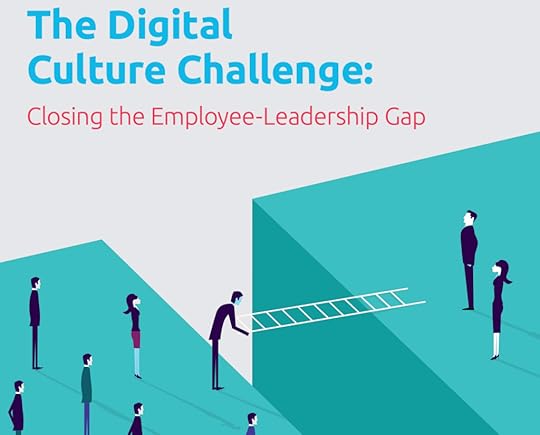
I would have forgotten all about this report I co-authored with Jerome Buvat of Capgemini in 2017 if I hadn’t received an email from Sara Fonseca from Insead. She’s working on research around the shaping of organizational cultures in the context of larger digital transformations. Her inquiry centered on our report that explored the expansive gaps between executives and employees around leadership, digital transformation, and culture, “The Digital Culture Challenge; Bridging the Employee-Leadership Disconnect.”
Her email inspired me to revisit the research, and wow, is it ever-relevant, especially in a time of AI. Feel free to sub the word ‘digital’ with ‘AI’ or ‘AI Ready’ and you’ll see that it’s pretty much the same…and…timely. In fact, I just wrote about the same type of gap for Forbes, “The AI Illusion: Why CEOs Must Confront The Gap Between Vision And Reality.”
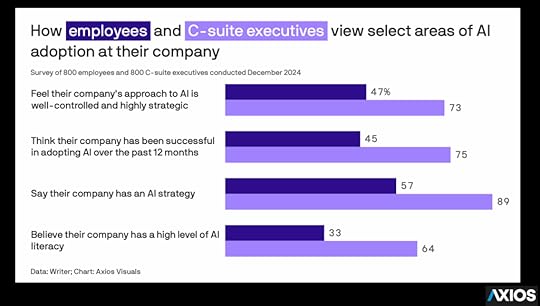
The comprehensive research says that 62% of respondents see corporate culture as one of the biggest hurdles in the journey to becoming a digital organization. As a result, companies risk falling behind competition in today’s digital environment. Furthermore, the data shows that this challenge for organizations has worsened since 2011 by 7 percentage points, when Capgemini first began its research in this area.
The report is embedded below…
Employees don’t see their company’s culture as ‘digital’The report, which includes more than 1,700 respondents in 340 organizations across eight countries, uncovers a significant perception gap between the senior leadership and employees on the existence of a digital culture within organizations. While 40% of senior-level executives believe their firms have a digital culture, only 27% of the employees surveyed agreed with this statement. The survey asked respondents to assess their companies’ digital culture based on seven attributes: their collaboration practices, innovation, open culture, digital-first mindset, agility and flexibility, customer centricity and a data-driven culture. Insights gathered from the report, and through a series of focus interviews, helped to identify some of the reasons behind this digital culture gap including senior leaders failing to communicate a clear digital vision to the company, the absence of digital role models and a lack of KPIs aligned to digital transformation goals.
Key report findings show that there is a profound disconnect between leadership and employees on all the dimensions of digital culture:
Innovation is still not a reality for many organizations. Only 7% of companies surveyed feel that their organization can test new ideas and deploy them quickly. This figure echoes employees’ sentiment about culture of innovation, with only 37% of respondents stating that their organizations have a culture of innovation, experimentation and risk-taking against 75% of senior executives. Organizations need to actively reward risk-taking and create an environment where employees can experiment.
There is strong disagreement on collaboration practices. The findings reveal a divide between senior-level executives and employees on collaboration practices. 85% of top executives believe that their organizations promote collaboration (or think AI empowerment or education) internally, while only 41% of employees agreed with this premise.
Leadership believes they have a digital vision, employees disagree. The research found considerable differences between what leadership and employees perceive as a clear digital vision. 62% of respondents in leadership positions affirmed they have a well-defined strategy to achieve their digital goals, while only 37% of employees agreed with this statement.
The report highlights that companies are failing to engage employees in the culture change journey. Getting employees involved is critical for shaping an effective digital culture and accelerating the cultural transformation of the organization. Leadership and the middle management are critical to translating the broader digital vision into tangible business outcomes and rewarding positive digital behaviors.
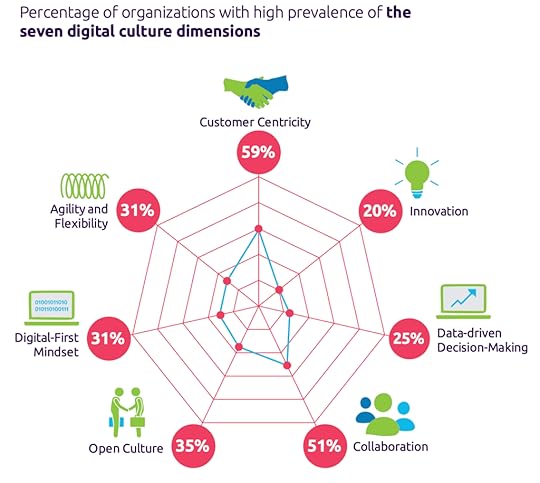
The research identified a group of digital culture ‘front-runners’ (34% of organizations surveyed) who performed consistently well across the seven dimensions of digital culture and whose leadership has largely succeeded in aligning the wider organization to the desired culture. The UK, Sweden and the US have a strong representation of digital culture leader organizations (63%, 60% and 56% respectively), while automotive (43%), consumer products (38%), and telecoms (32%) have the highest proportion by industry sector.
These digital culture front-runners tend to hire differently than their digital slow-moving counterparts, consciously looking for behavioral traits such as creativity and autonomy when recruiting – 83% of front-runners compared to 29% of the digital slow moving counterparts; adjusting role descriptions and KPIs to align with overall digital transformation (75% compared to 17%) and aligning their compensation structure to digital transformation objectives (70% compared to 13%).
How to create a digital culture?Creating a digital culture and affecting change requires patience, tenacity and constant vigilance. The report sets out some key elements needed for organizations to adopt a digital culture:
Deploy digital change agents and empower employees to drive a digital culture
Design new digital KPIs that focus on behaviors
Make digital culture change tangible
Invest in the digital skills that matter
Clearly communicate a digital vision and have visible leadership involvement
Use digital collaboration tools to increase transparency and to reach out to employees
Take a systems thinking approach to culture change
This research provides insights on the challenges organizations face to build a digital culture. The report covers the views of 1,700 respondents from 340 organizations who participated in the survey. Participants included 20 per cent of senior executives, 40 per cent middle management respondents and 40 per cent employees in non-supervisory roles across five industry sectors: automotive, banking/insurance, consumer products, retail and telecommunications. In addition, Capgemini conducted a series of focus interviews with academics, industry top executives and employees. Countries represented were the United Kingdom (UK), France, Germany, Italy, Sweden, Netherlands, Spain and the United States (US).
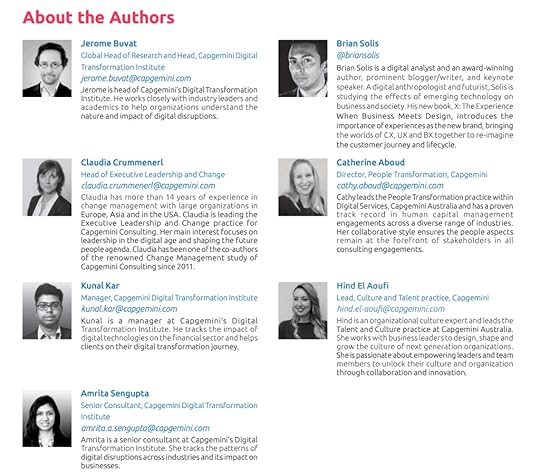
The post The Digital (and AI) Culture Challenge; Bridging the Employee-Leadership Disconnect appeared first on Brian Solis.
July 31, 2025
Leadership needs a mindshift: A conversation with Brian Solis
So many things are changing right now, except our mindsets. To thrive in this renaissance, future leadership requires a mindshift.
If you haven’t met NTT DATA’s Tammy Soares yet, this is a good time. I had the absolute pleasure of spending time with her on the Catalyst podcast to talk about why the time is now to challenge your own thinking, your current mindset. We often think that change is for others, when in fact, change is for all of us now and permanently moving forward.
In this podcast, we explore how leaders (you and me) must evolve in the age of AI and rapid disruption.
Other reasons to listen…
1⃣ To discover how genuine curiosity drives meaningful innovation, especially with AI.
2⃣ To learn why AI should enhance human courage and creativity, not preserve and scale the status quo.
3⃣ To hear practical examples of how a “mindshift” mentality unlocks entirely new value rather than incremental gains.
Highlights from the episode include:
True futurism is about curiosity, not predictions. A futurist doesn’t predict the future but asks critical questions, analyzes data and develops potential scenarios. Brian emphasizes that challenging assumptions and rules is essential for innovation and creative thinking.The human cost of efficiency. Years of digital transformation have focused on cost reduction and efficiency at the expense of human experience. Brian shares examples like IKEA’s chatbot success leading to new interior design services, showing how different thinking can create value rather than just cutting costs.Beware the “AI-powered status quo.” The companies that will win in this next era have leaders who are willing to reimagine what’s possible, instead of simply digitizing what already exists. When humans and AI collaborate to create entirely new value propositions, things get interesting.Please listen here  or here…
or here…

The post Leadership needs a mindshift: A conversation with Brian Solis appeared first on Brian Solis.
July 29, 2025
To Win in the AI Economy, You Need More Than a Strategy, You Need a Mindshift
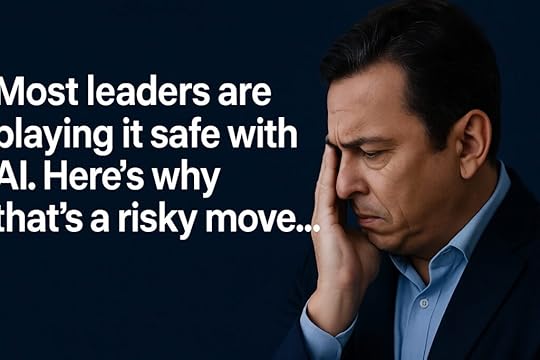
Earlier this year, I was asked to deliver the opening keynote at Avasant’s Empowering Beyond Summit. The event was attended by some of the most influential leaders in business and technology. I learned from each of them their challenges and opportunities with AI and wanted to share my takeaways here. Also, the team uploaded the presentation to Youtube and I’ve included it below! 
When people talk about AI, they often default to automation. It’s the low-hanging fruit…faster execution, lower costs, streamlined operations. But automation is only one side of the AI coin. The other side, the more powerful, game-changing side, is augmentation. But for some reason, we don’t really want to talk about it. Why? Maybe because at its core, we’re really talking about innovation and transformation. And even though it’s reimagination, change is hard…and expensive. But ignoring it doesn’t in any way ensure survival. So, we ignore it at our own peril.
Start with a mindshift.
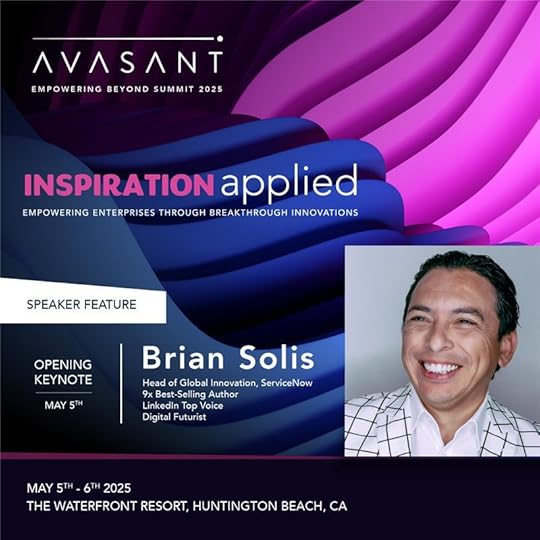
At Avasant’s Empowering Beyond Summit in Huntington Beach, I spoke to a room of global technology and business leaders about what AI really represents. Spoiler: it’s not digital transformation. That era, defined largely by digitizing legacy processes, is over. This is business transformation. And AI is not just the next tool in the box. It’s the beginning of a new box entirely.
We’re Not Thinking Big EnoughLet’s be honest. The appetite for transformation isn’t widespread. Most executives don’t want to invent the future, they just want to improve yesterday for tomorrow while taking out costs and driving efficiency. The problem? That’s not transformation. That’s iteration. And iteration eventually loses its capacity to defend against digital Darwinism.
If we keep using AI to do the same things slightly better, faster, or cheaper, we’ll get efficiency. But we won’t get reinvention. The real value of AI doesn’t lie in what it can do for our current operations. It lies in what it enables us to do that we never could before.
Leaders are already promising the street that AI will deliver performance gains. Yet behind closed doors, many admit they’re ambivalent or dissatisfied with the ROI. Why? Because we’re still coloring inside the lines of the old business model. AI deserves…and demands…an entirely new canvas.
The Iteration-Innovation GapMost companies today are investing in what I call optimized AI, deploying tools to supercharge legacy workflows. And that’s fine. But it’s not a revolution. Innovative AI, on the other hand, explores use cases that never existed, redesigns workflows for exponential outcomes, and asks questions like “What would AI do?” instead of “How can AI help me do what I’ve always done?”
Too many executives are still playing it safe, waiting for use cases to become obvious. But transformation doesn’t come with a prewritten playbook. If you wait until there’s a roadmap, you’re already behind.
The Risk Isn’t AI. The Risk Is Inaction.Venture capitalists understand this intuitively. When they back a startup, they’re not looking for a 10x return. They’re looking for 1000x…moonshot ideas that redefine industries. Founders don’t show up with risk-averse ideas or fully validated business models. They lead with vision.
Why should enterprise leaders be any different?
We need to borrow that VC mindset and apply it to how we invest in AI. That means creating space for innovation, rewarding calculated risk, and enabling teams to operate outside the boundaries of business as usual. It also means acknowledging that the biggest barrier to scale isn’t talent. It’s us…the leaders, decision-makers, shareholders and stakeholders, and boards.
Automation vs. Augmentation: The IKEA LessonOne of my favorite recent examples of augmentation comes from IKEA. They deployed an AI chatbot, “Billy,” which handled 57% of customer service inquiries. But instead of laying off staff, IKEA reimagined the remaining 43% of calls, many of which were about interior design, and reskilled those employees as design consultants. The result? A brand-new service and €1 billion in new revenue in one year.
That’s what augmentation looks like: not just doing the same work with fewer people, but using AI to create entirely new value. That’s the kind of thinking every leader needs to adopt.
Mind the (Leadership) GapRecent studies show that executives overwhelmingly believe their companies are ahead in AI adoption. Their employees, however, aren’t on the same page. Whether it’s AI strategy, literacy, or execution, the perception gap is real, and dangerous.
You can’t lead people into the future if they don’t understand the mission. AI transformation requires culture change, new mental models, and above all, psychological safety. Google’s own research shows that high-performing teams are not the ones with the best credentials. The HiPo teams feel safe to experiment, challenge conventions, and ask bold questions.
It’s Time to Rewrite the Org ChartYes, AI will be on your org chart. But the more important question is: where? And how will it collaborate with your people? Augmented intelligence isn’t about replacing humans; it’s about unlocking capacity, creativity, and entirely new performance metrics.
We need to redesign job descriptions so they reflect AI-human collaboration. We need to reward people not just for doing their jobs more efficiently, but for doing things AI enables them to do that were previously impossible.
This is how we move from automation to transformation. This is how we build infinitely scalable organizations.
The Road Ahead: Business Acceleration Over Digital TransformationForget digital transformation. It’s time for business acceleration. For platform thinking. For bold investments in innovative AI alongside the iterative.
The question is more than “How can we use AI to automate and save costs?” It’s:
What new capabilities can we unlock?
What new business models can we design?
In which ways can AI help us create new value?
What would our company look like if we started today with AI at the core?
You are the Leader Behind the LeaderLet’s face it: most boards and C-suites still don’t know what they don’t know. That’s where you come in.
You are the visionary who helps them see what’s possible. You are the catalyst who shifts the conversation from “What can we automate?” to “What can we create?” You are the leader behind the leader.
In the end, a great leader doesn’t just adapt to the future. They invent it. And if we do this right, AI is both a tool to survive. And it’s a partner we collaborate with to innovate and thrive!
Are you ready for a Mindshift ?
Book Brian to speak at your event!
The post To Win in the AI Economy, You Need More Than a Strategy, You Need a Mindshift appeared first on Brian Solis.
July 25, 2025
Beyond the Hype: The Real State of AI in Business
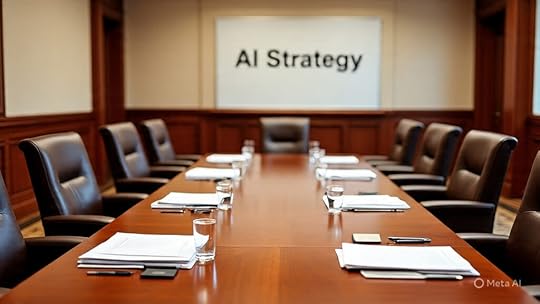
Let me ask you a question…
What’s moving faster, AI innovation or the rate at which organizations fall behind?
While AI continues to advance at breakneck speed, many legacy companies are struggling to keep pace. The real challenge isn’t the technology itself, but the growing gap in alignment and execution. Most CEOs and board members believe they’re confidently leading their organizations into the AI era. Yet new data reveals a stark disconnect between the C-suite and frontline employees when it comes to what’s actually happening on the ground.
According to an Axios survey that interviewed CEOs and their employees, separately, AI vision, strategy, and capacity may be a dangerous illusion.
Axios learned that CEOs may feel they are steering their companies into an AI-powered future. But if the people responsible for delivering on that vision don’t feel informed, empowered, or included, then the transformation will fail to take root. Sound familiar?

Let’s talk about it!
C-Suites are mistaking AI vision with tactical strategy. And they’re mistaking AI strategy for strategy activation. Employees don’t feel the impact, which means vision isn’t articulated and strategy isn’t embedded.
The Illusion of Vision and StrategyNearly 90 of C-Suites say their company has an AI strategy. Yet only 57% of employees believe that to be true.
This suggests that while the strategy might exist in executive slide decks or boardroom conversations, it hasn’t been translated into the day-to-day reality for most employees. For them, the strategy is either invisible or irrelevant. Again, sound familiar?
The Illusion of SuccessExecutives also believe they’ve made meaningful progress. Seventy-five percent say the company has been successful in adopting AI over the past 12 months. But just 45% of employees agree. If employees aren’t feeling the impact of success, that means the change isn’t penetrating deeply enough. If those delivering the work don’t feel the benefits, innovation won’t scale.
The Illusion of ControlAnother significant divide emerges when asked whether the company’s approach to AI is “well-controlled and highly strategic.” While 73% of C-suite leaders say yes, only 47% of employees agree. That’s a 26-point gap in perception and reality!
A strategy is only as effective as it is understood and executed across the organization. If people perceive confusion or chaos where leadership sees control, well, you can imagine what happens next.
From Illusion to IntrospectionIf the first set of data reveals a disconnect between leadership and the workforce, the second reveals something even more revealing. Here, we shift to a profound introspection among CEOs themselves. They reveal more than disconnects in communication. They’re disconnects of modern leadership.
The illusion of progress is being shattered by the very leaders tasked with shaping the future. CEOs are quietly confessing that AI is transforming how businesses operate. And it’s redefining who leads, how decisions are made, and what it takes to stay relevant.
Let’s compare these findings to the Dataiku/Harris, “Global AI Confessions Report: CEO Edition.” This survey of 500 CEOs worldwide unveils startling admissions and revelations of Al’s impact on corporate leadership and competitive survival.
94% of CEOs admit an Al agent could provide equal or better counsel on business decisions than a human board member.What it means (WIM):
The boardroom is no longer immune to disruption. AI literacy is now a fiduciary responsibility. Boards must evolve from oversight to insight, becoming fluent in AI, risk, and opportunity at the same pace as the technology itself.
What to do (WTD):
Establish an AI Board Advisor Program to embed AI-powered agents and advisors alongside traditional governance models.
Test AI-simulated board scenarios to understand what it sees that your board doesn’t.
89 of CEOs feel AI can develop an equal or better strategic plan than a member of their own exec team.WIM:
Strategic planning is no longer a purely human exercise. The executive bench must now compete and collaborate with algorithmic intelligence and do so quickly and visibly. The future leadership team will be hybrid: human + digital counterparts.
WTD:
Augment strategic planning with AI agents that simulate market changes, competitor responses, and future scenarios (agents as digital twins FTW!)
Redesign the org chart with AI-native roles. Train your teams to collaborate with AI not just as tools, but as cognitive partners.
74% of CEOs admit they’ll lose their job within 2 years if they don’t deliver Al business gains.WIM:
The AI clock is ticking, and the innovation imperative is rising. AI native companies are moving the game from an era of AI experimentation to execution. AI-forward boards and shareholders will learn to see AI beyond a tool or technology investment, and instead as a performance expectation and competitive driver.
WTD:
CEOs must shift from exploring peer-driven AI use cases to engineering AI-native business models. Leaders must stop waiting and start leading.
Create an AI Transformation Office to orchestrate enterprise-wide AI initiatives, beyond the AI ‘status quo’ pilots.
Tie AI metrics to business outcomes including, revenue growth, margin expansion, NPS, time to market. Develop a real AI vision!
Publish a 12-month AI innovation roadmap to the board, employees, and investors. Then, deliver and report against it.
68% of CEOs claim they are involved in more than half of their companies’ Al-related decisions.WIM:
CEOs understand, or are starting to, grasp the stakes and are stepping in and stepping up. But involvement doesn’t equal empowerment. AI readiness, AI fluency, and AI empowerment must be democratized across the enterprise, as tied to the vision.
WTD:
Build AI leadership coalitions or cross-functional stakeholder groups across functions, influencing but not limited to IT, to scale decision-making.
Bring in the outsiders to develop and execute an AI upskilling initiative across all management tiers.And perhaps the least intuitive of the bunch, distribute decision-making authority to AI-augmented teams trained to act with speed and insight.
From Reckoning to RenaissanceThis is a reckoning and the beginning of something bigger. It’s AI transformation tied to leadership transformation.
The AI era demands a new leadership mindset. A new vision for what’s possible. A new language. A new social contract between leaders and their organizations.
That starts by closing the gap between perception and reality. It means rethinking leadership. It means moving beyond platitudes. You can’t scale what your teams don’t understand. And you can’t scale what you do not understand.This moment demands a bold new vision and a clear strategy. It demands action and empowerment across the organization. It also demands measurable alignment between boardroom intent, C-Level promises, and frontline execution.
Without vision and alignment, AI remains theater. Without shared understanding, transformation stalls. And without communication and enablement, trust fails to materialize. The companies that succeed unite AI and business leadership, innovation, and culture.
The renaissance starts with a mindshift.
The post Beyond the Hype: The Real State of AI in Business appeared first on Brian Solis.
July 20, 2025
What Happens to Companies That Don’t Think Big Enough with AI?
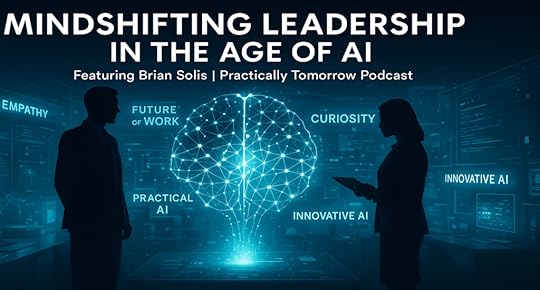
I had the privilege of joining GoTo CMO Peter Mahoney on the Practically Tomorrow podcast. We talked about one of the most urgent, and misunderstood, topics of our time: how AI is reshaping the world of work. But this wasn’t just another conversation about automation and productivity. It was a much deeper exploration of how we need to rethink leadership, empathy, and innovation in the age of intelligent machines.
“The most dangerous thing for any organization of any size is when we do not think big enough with what we can do with AI.”

It’s tempting for companies to treat AI as a faster horse, another tool to speed up existing processes or reduce costs. But that’s not transformation. That’s stagnation, accelerated.
True transformation begins when we ask: What can we do now that was never possible before?
That’s why I draw a distinction between practical AI and innovative AI as inspired by GoTo’s research, “The Pulse of Work in 2025.”
Practical AI improves efficiency, reduces routine, and scales productivity.
Innovative AI creates new products, services, experiences, and even entirely new business models.
Most companies start with the practical. The most courageous and visionary leaders learn to balance both.
Curiosity Is the New Superpower“AI isn’t here just to optimize yesterday’s work. It’s here to open up new frontiers of value creation.”
AI is a blank canvas. But many leaders are painting with old brushes. In the podcast, we explored how many employees, and even executives, aren’t getting the most out of AI because they’re using it like search engines. They’re prompting from yesterday’s mindset.
“You can’t imagine a better future if you’re looking at it through the same lens that created the past.”
If there’s one practical takeaway I’d offer any business leader, it’s this:
“Be curious. Lean into what you don’t know you don’t know. Ask what you can now do with AI that you couldn’t before.”
This curiosity unlocks a new mindset—one that helps you build not just a more efficient organization, but a more adaptive, inspired one.
Empathy Is Your Competitive AdvantageOne of the most surprising and overlooked side effects of our accelerated digital lives is what I call digital narcissism. It’s not just a buzzword. It’s a behavioral shift where people have become the center of their own digital ecosystems, with heightened expectations and lower patience.
That makes empathy the most powerful (and underutilized) tool in your leadership toolbox.
“Empathy is experience. And experience is a feeling. There are only two kinds of experiences people remember…those that are amazing and those that suck.”
In the episode, I shared stories from working with retail leaders who had to walk through their own customer experiences to truly feel what their customers go through. When we embrace empathy, by observing, experiencing, and listening, we design better services, more engaging experiences, and ultimately, more resilient businesses.
AI Is a Mirror, ButWhat Will It Reflect?One of the most important insights I’ve taken from years of studying technological shifts is this:
“AI will not just change how we work, it will reveal who we are.”
Some companies are already operating like 24/7 organizations where AI continues to deliver value after hours. In time, AI will level the playing field between SMBs and large enterprises. Those who move first, who rethink work, who redesign experiences, who reimagine leadership, will set the pace for everyone else.
Want to Hear the Full Conversation?This article only scratches the surface. In the full episode of Practically Tomorrow, Peter and I discuss:
How AI impacts leadership and boardroom dynamics
Why storytelling is the key to inspiring change
How to balance linear growth with exponential innovation
The future of experience design in an AI-powered world
If you’re leading, or aspiring to lead, through this next chapter of technological disruption, I hope this conversation and these reflections give you a new lens to look through.
Let me know what you think, and share the episode with someone who’s ready to move from automation to transformation.
Listen now on Spotify
Learn more about my book Mindshift
The post What Happens to Companies That Don’t Think Big Enough with AI? appeared first on Brian Solis.
July 14, 2025
Designing the AI-Powered Workplace: What Workers Want, and Why It Matters
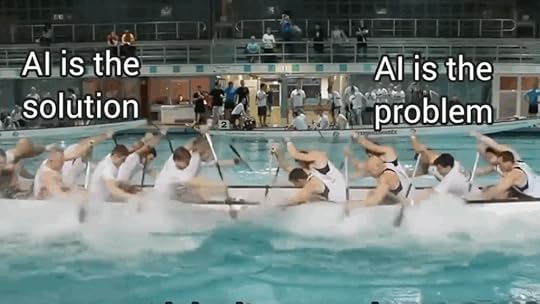
What do real workers want from AI? And how does that differ from what AI experts think?
Let’s explore an insightful study recently published by Stanford University Social and Language Technologies Lab, “Future of Work with AI Agents.”
Drawing on over 2,100 tasks across 104 occupations, the research compares how workers and AI experts think about automation (what AI should do on its own) and augmentation (where AI should collaborate with humans).
Two groups were surveyed:
1,500 domain workers — the people doing the jobs.52 AI experts — those building the tools.The results are grounded in O*NET, the U.S. Department of Labor’s job database, and offer a rare task-level view into where humans want to stay involved, and why.
The key takeaway? Workers don’t just want to keep their jobs; they want AI to work with them, not instead of them, especially in areas involving communication, judgment, and human connection. But don’t stop here. There’s so.much.more.
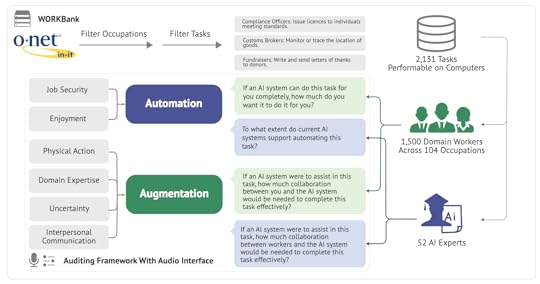
This first visual is a snapshot from a large-scale research effort aimed at answering a critical question:
How do workers and AI experts differ in their views on which tasks should be automated — and which should be augmented by AI?
The study analyzes over 2,100 tasks across 104 occupations, using task-level data to explore two key dimensions:
How much human involvement do workers want in their day-to-day tasks?How much AI involvement do experts believe is technically feasible ?Two key perspectives were measured:
Automation (blue): Tasks that AI could perform entirely on its own — and how workers feel about that possibility.Augmentation (green): Tasks where AI could assist humans — and the ideal level of collaboration between the two.The researchers surveyed two distinct groups:
1,500 domain workers — people currently performing these tasks in the real world52 AI experts — technical professionals evaluating AI’s capabilitiesEach group was asked:
For automation: Can AI do this task alone? Should it?For augmentation: If AI helps, what’s the right balance between human and machine input?The findings reveal several drivers behind workers’ preferences:
Job security and enjoyment tend to make workers resist full automation.Tasks requiring expertise, judgment, or interpersonal interaction lean heavily toward augmentation.Physical tasks fall somewhere in between, depending on the nature of the work.In short, this research highlights the nuanced ways people think about AI — not just as a tool, but as a collaborator, and sometimes, as a competitor.
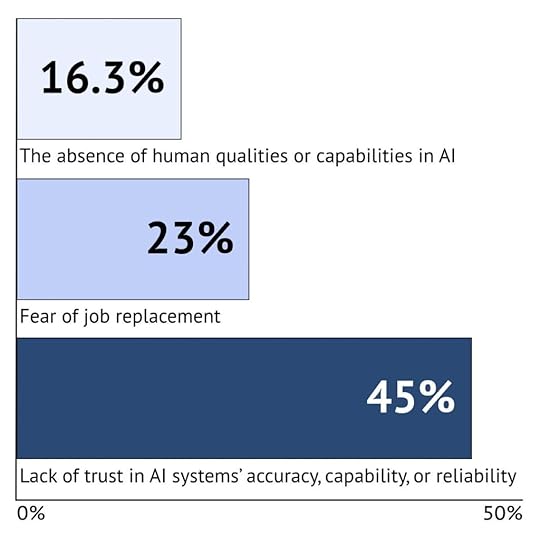
As technology advances, worker perspectives are too often left out of the conversation.
So, what do workers actually want AI to automate, and where do they prefer human-AI collaboration? Oh, and how do those preferences stack up against what the technology can realistically do?
As part of the study, workers shared their top concerns about AI’s role in their jobs:
45% said they don’t trust AI to handle their tasks responsibly23% fear being replaced entirely16% worry about the loss of the human touch in their work
These aren’t just statistics, they’re usable signals. Signals that any future of work built with AI needs to be designed for people, not just for performance or stakeholders or shareholders.
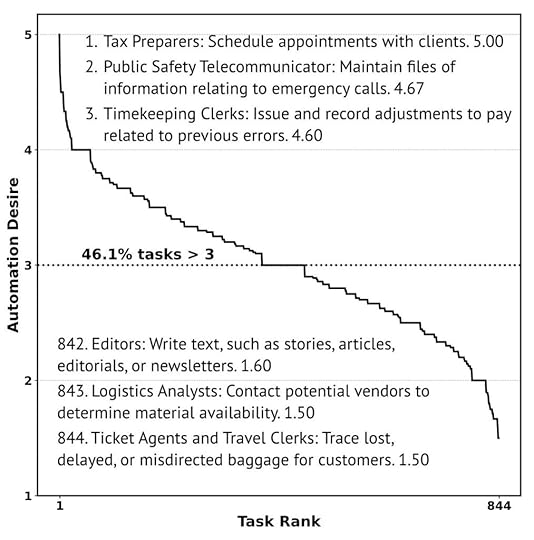
In the study, 46.1% of tasks were rated positively for full AI automation by the workers who actually perform them. That means nearly half the time, people said they would welcome AI doing the task entirely…even after considering risks like job loss and reduced enjoyment.
This signals a key nuance: workers aren’t simply resistant to AI, they’re open to it when it offloads routine, repetitive, or less meaningful work. As the popular ideology goes, this frees them to focus on what matters more.
The challenge isn’t just what AI can do. It’s what people are willing to let go of…and why. So, so, so, important and under-explored!
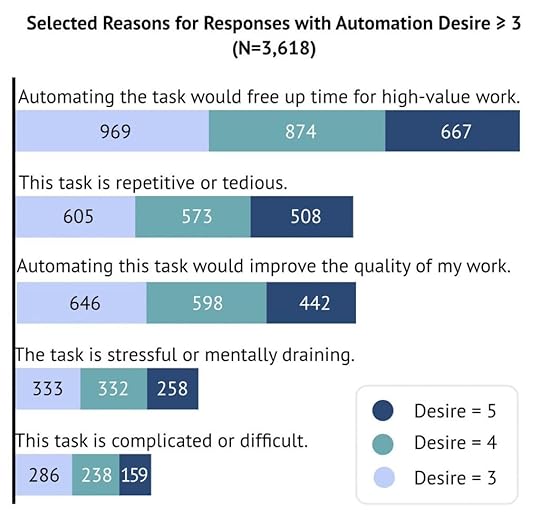
When workers express a desire for automation, it’s not because they want to do less — it’s because they want to do better.
Among the 3,618 task responses where workers rated their automation desire at 3 or higher (on a 5-point scale), the most common motivations were:
69.4% — Freeing up time for high-value work46.6% — The task is repetitive or tedious46.6% — Automation could improve work quality25.5% — The task is stressful or mentally draining
While some also cited tasks being complicated or difficult, the bigger theme was clear: Workers are most open to automation when it relieves low-value, exhausting, or repetitive work, giving them more time and mental space (yes please) for the parts of their job that matter most.
In other words, automation isn’t just about efficiency. It’s about making room for meaning.
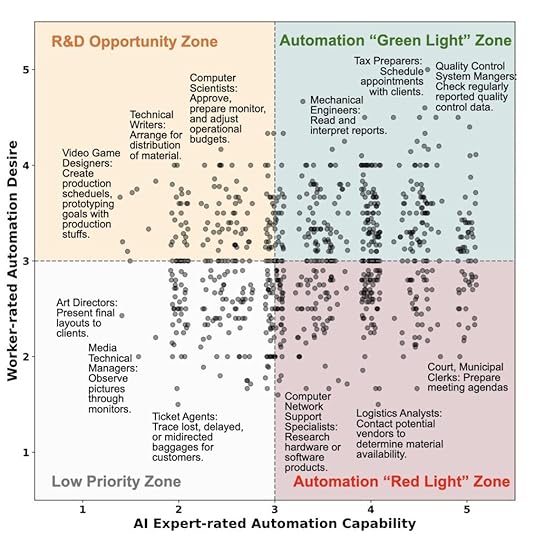
To help guide where AI agent investments should (and shouldn’t) go, Stanford researchers identified four distinct “task zones” based on two key factors:
Worker desire for automationAI expert assessment of technical capabilityThese zones provide a framework to align technological potential with human values:
1. Automation “Green Light” = Zone High worker desire, high AI capability.
These tasks are ideal candidates for automation. They promise strong productivity gains and broad worker support, making them low-friction wins for AI deployment.
2. Automation “Red Light” = Zone Low worker desire, high AI capability.
Technically, AI can handle these tasks, but workers don’t want it to. Automating here risks resistance, lower morale, or broader social backlash. Caution is advised.
3. R&D Opportunity Zone = High worker desire, low AI capability.
Workers want help here, but AI isn’t ready yet. These tasks point to valuable frontiers for research and innovation, where investment could deliver strong future payoff.
4. Low Priority Zone = Low worker desire, low AI capability.
These tasks are unlikely to benefit from automation in the near term, and workers aren’t asking for it. It’s probably best to deprioritize for now.
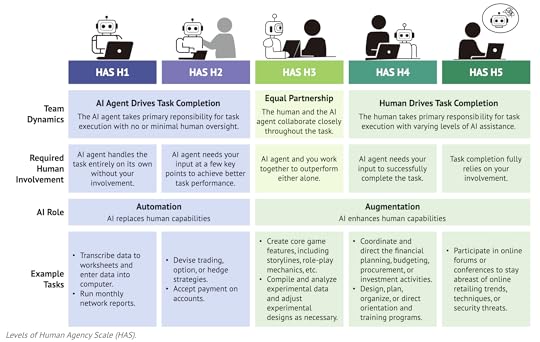
While much of the conversation around AI focuses on automation, Stanford’s research also explored the other side of the equation: augmentation. This is where AI supports, rather than replaces, human effort.
To analyze this, the team introduced a new framework: the Human Agency Scale (HAS).
The HAS is a five-level scale that measures how essential human involvement is for a task to be done well — from H1 (fully autonomous) to H5 (human-led and AI-assisted…if at all).
The HAS centers on human value, judgment, and the need for involvement, even in cases where automation is technically possible.
This shift from an “AI-first” model to a “human-centered” one offers a more nuanced way to decide not just what can be automated, but what should be augmented…and why.
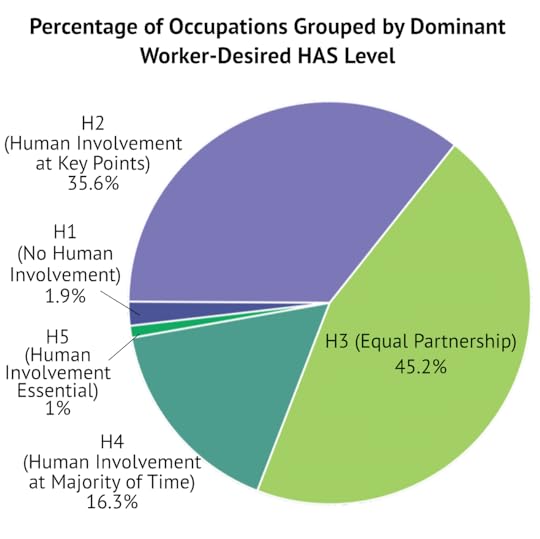
Stanford’s research shows that across many occupations, workers aren’t looking for full automation. I mean, who is!? Instead, they prefer a collaborative relationship with AI, one that balances machine support with human judgment.
On the Human Agency Scale, this balanced view is captured by H3: Equal Partnership, where humans and AI share responsibility for completing a task.
H3 emerged as the dominant preference in 45.2% of occupations (47 out of 104) — making it the most common worker-desired level overall.
Other preferences were:
H2 (AI support with human oversight at key points): 35.6%H4 (Human-led, AI assists most of the time): 16.3%H1 (Full automation): 1.9%H5 (Human-only, no AI): 1.0%The takeaway? Even as AI grows more capable, workers want to stay meaningfully involved. They’re not asking to be replaced. As if that were a thing! They’re asking for shared control, trust, and agency.
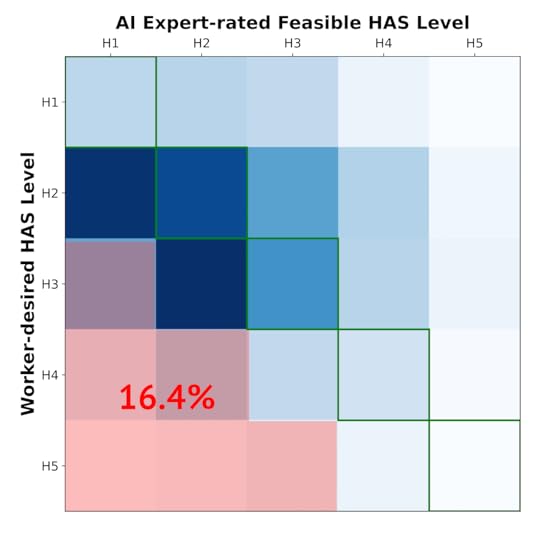
As AI capabilities advance, a growing gap is emerging, not in what’s possible, but in what people actually want.
Stanford’s analysis shows that in 47.5% of the 844 tasks studied, workers prefer to retain more human involvement than AI experts believe technically necessary. What this means is that workers are leaning toward higher levels of human agency, even when AI could, in essence, take on more of the task.
This misalignment is clearly visible in the heat map above.
Cells below the diagonal (like H4 worker preference vs. H2 expert feasibility) show tasks where workers want more involvement than AI experts recommend.That red-shaded area (16.4%) highlights just one such region. This is a clear signal of emerging tension.The implication? As AI gets more powerful, it’s not just a question of what we canautomate, but whether people will trust, accept, and support that automation. And that right there is all about vision and comms.
Designing AI for the workplace means building with human values at the core, not just technical efficiency. But, that’s been true with every technology revolution.
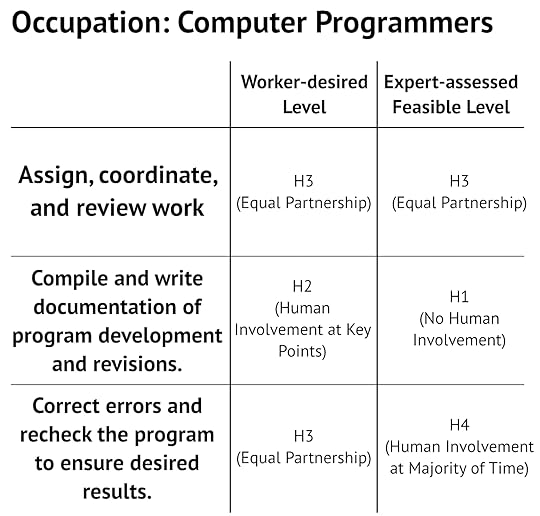
Different tasks within a single job may require very different levels of human involvement, trust, and judgment, and should not be automated in the same way. 100%!
Take the role of a computer programmer: it’s highly technical, data-driven, and already deeply intertwined with digital tools. And yet, when you break it down task by task, the desired role of AI varies dramatically.
According to Stanford’s study:
For assigning and reviewing work, both workers and experts aligned on equal partnership (H3).For writing documentation, AI experts saw no need for human input (H1), but workers still preferred key-point involvement (H2).For debugging and correcting errors, workers leaned toward equal collaboration (H3), while experts rated it feasible with less human input (H4).This mismatch shows that even in high-tech roles, trust and control are critical.
If AI agents are deployed in high-agency tasks without human in the loop design, the risks go beyond performance:
Users may reject or ignore the tools.They may override AI outputs entirely.They may feel disempowered and morale will sink, eroding trust and job satisfaction.AI success depends as much on human alignment as it does on technical capability.
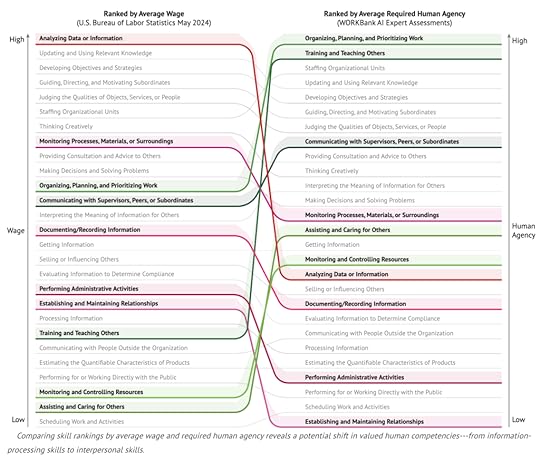
This chart above offers a powerful perspective shift: Instead of ranking skills by how much they currently pay, it ranks them by how much human agency AI experts believe they require.
When we compare these two views, 1) economic, 2) human-centered, three key trends emerge:
1. Information-processing skills may decline in relative valueSkills like analyzing data, updating knowledge, and documenting information rank high by wage, but lower in required human agency. As AI becomes better at handling these tasks, their reliance on human input, and their unique value as human work, may shrink. *sigh*
2. People and coordination skills become more essentialTasks like organizing work, training others, and communicating with peers may not always top wage charts, but they dominate in terms of human involvement. These are skills that resist full automation because they rely on emotional intelligence, situational awareness, critical thinking, and collaboration.
3. High-agency skills are broad, interpersonal, and deeply humanTasks requiring high human agency span a wide range…from planning and teaching to decision-making and motivating others. They reflect not just what people do, but how they lead, guide, and connect with others.
As AI handles more of the technical, repetitive, or informational work, the skills that will define human value are the ones that machines can’t replicate: Judgment. Empathy. Leadership. Trust.
This is a shift in what we value in work, and in each other.
As AI advances, human skills will matter more than everAs machines take on more routine, data-driven tasks, the skills that truly differentiate people, collaboration, leadership, communication, and nuanced judgment, will only grow in importance.
To build a future of work that works for everyone, here are three essential takeaways:
1. AI adoption must be task-aware, not job-aware.Jobs are made up of many tasks, and, not all are created equal. Some tasks within a single role may be ideal for automation, while others require thoughtful human-AI collaboration. Successful AI implementation depends on understanding this task-level nuance.
2. There’s a gap between technical feasibility and worker comfort.Workers often want more control and involvement than AI experts think is necessary. Ignoring this mismatch could slow adoption, reduce trust, or lead to resistance. Managing that tension is critical. Anticipating it is now an option. And it all must be done with thoughtfulness, transparency, and feedback.
3. Use the Human Agency Scale to guide responsible transformation.The HAS framework helps organizations identify which tasks should be:
Automated,Augmented,Or left entirely human.By anchoring AI strategy in human-centered design and empathy, companies can deploy tools and AI agents people actually want to use and work with. This will lead to better adoption, more trust, and more responsible innovation.
Remember…AI doesn’t replace people, it reshapes work. That’s if you want it to. It’s a choice. Let’s make sure it does so in ways that elevate what makes us human and what makes us better with AI and makes AI better with us!
The post Designing the AI-Powered Workplace: What Workers Want, and Why It Matters appeared first on Brian Solis.

